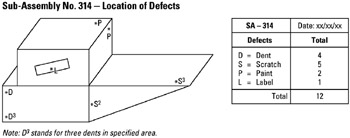Tool 60: Defect Map
| AKA | Defect Location Checksheet, Concentration Diagram |
| Classification | Data Collecting (DC) |
Tool description
A defect map displays the location of defects and simplifies the process of data collection and repair. Problem locations are marked so that repair staff know where to look.
Typical application
-
To point to the location of defects or problems on rejected products.
-
To mark or check off the locations of defects on an assembly diagram for the purpose of collecting frequency data of the various defects observed.
Problem-solving phase
| → | Select and define problem or opportunity |
| → | Identify and analyze causes or potential change |
| Develop and plan possible solutions or change | |
| Implement and evaluate solution or change | |
| Measure and report solution or change results | |
| Recognize and reward team efforts |
Typically used by
| Research/statistics | |
| Creativity/innovation | |
| 4 | Engineering |
| Project management | |
| 1 | Manufacturing |
| Marketing/sales | |
| 3 | Administration/documentation |
| Servicing/support | |
| 2 | Customer/quality metrics |
| Change management |
before
-
Data Collection Strategy
-
Checksheet
-
Checklist
-
Observation
-
Quality Chart
after
-
Pareto Chart
-
Problem Specification
-
Failure Mode Effect Analysis
-
Potential Problem Analysis (PPA)
-
Countermeasures Matrix
Notes and key points
-
Use checksheets to record and summarize various defect map data.
Step-by-step procedure
-
STEP 1 A defect map can be drawn for specific parts, assemblies, or complete units of product. Assembly drawings can also be used as defect maps. See example Sub-Assembly No. 314—Location of Defects.
-
STEP 2 During inspection of parts, assemblies, or units, the observed location of defects is marked on defect maps.
-
STEP 3 Defect types, locations, and frequencies are summarized on a checksheet as shown in the example.
-
STEP 4 Use this type of historical defect data to prepare a problem specification statement.
-
STEP 5 Provide notes on drawings, and date all documentation.
Example of tool application
Sub-Assembly No. 314—Location of Defects

EAN: 2147483647
Pages: 326
- ERP System Acquisition: A Process Model and Results From an Austrian Survey
- The Effects of an Enterprise Resource Planning System (ERP) Implementation on Job Characteristics – A Study using the Hackman and Oldham Job Characteristics Model
- Distributed Data Warehouse for Geo-spatial Services
- Healthcare Information: From Administrative to Practice Databases
- A Hybrid Clustering Technique to Improve Patient Data Quality